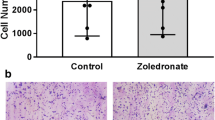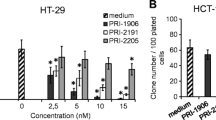Abstract
Although 1,25-dihydroxyvitamin D3 is a potent cell-differentiating agent, its use in cancer prevention or therapy is precluded because it induces hypercalcemia. Synthetic analogs have been developed which inhibit tumor progression in animal models of breast cancer. One analog, Seocalcitol (EB1089) has been shown to be effective in causing regression of N-methyl-nitrosourea-induced rat mammary tumors. However, at the most effective oral dose, a significant increase in serum and urinary calcium levels were observed. In order to compare the efficacy of different dosing schedules of Seocalcitol, rats were treated either 6 times weekly (1 µg/kg) or by intermittent dosing to achieve the same total weekly dose. All dosing schedules of Seocalcitol were effective in inhibiting tumor progression. Once daily dosing was significantly more effective than intermittent dosing but was associated with a greater rise in serum calcium concentration. In order to evaluate alternative treatment strategies to limit calcemic effects, we assessed the efficacy of limiting vitamin D-induced hypercalcemia using bisphosphonates. Seocalcitol (2.5 µg/kg daily p.o. for 4 weeks) alone and in combination with pamidronate (APD 0.4 mg/kg per day s.c.) or the same dose of the bisphosphonate EB1053 caused substantial tumor regression. No statistically significant difference was seen between combination treatment and Seocalcitol treatment alone. Co-treatment with APD or EB1053 did not limit the rise in serum calcium induced by Seocalcitol alone. Cessation of treatment or administration of a lower dose (1 µg/kg twice weekly) reversed hypercalcemia, hypercalciuria and weight loss induced by high dose Seocalcitol. However, reduction in tumor volume was maintained in the majority of animals.
Similar content being viewed by others
References
Early Breast Cancer Trialists' Collaborative Group: Tamoxifen for early breast cancer: an overview of the randomised trials. Lancet 351: 1451–1467, 1998
Berger U, Wilson P, McClelland R, Colston K, Haussler MR, Pike JW, Coombes RC: Immunocytochemical detection of 1,25-dihydroxyvitamin D3 receptor in primary breast cancer. Cancer Res 47: 6793–6795, 1987
Berger U, McClelland RA, Wilson P, Greene GL, Haussler MR, Pike JW, Colston K, Easton D, Coombes RC: Immunocytochemical detection of estrogen receptor, progesterone receptor and 1,25-dihydroxyvitamin D3 receptor in breast cancer and relation to prognosis. Cancer Res 51: 239–244, 1991
Colston KW, Mørk Hansen C: Mechanisms implicated in the growth regulatory effects of vitamin D in breast cancer. Endocr Rel Cancer 9: 45–59, 2002
Mørk Hansen C, Binderup L, Hamberg KJ, Carlberg C: Vitamin D and cancer: effects of 1,25(OH)2D3 and its analogs on growth control and tumorigenesis. Frontiers Biosci 6: 820–848, 2001
Colston KW, Mackay AG, James SY, Binderup L, Chander S, Coombes RC: EB1089: a new vitamin D analogue that inhibits the growth of breast cancer cells in vivo and in vitro. Biochem Pharmacol 44: 2273–2280, 1992
Mackay AG, Ofori-Kuragu EA, Lansdown A, Coombes RC, Binderup L, Colston KW: Effects of the synthetic vitamin D analogue EB1089 and tamoxifen on the growth of experimental rat mammary tumours. Endocr Rel Cancer 3: 327–335, 1996
James SY, Mercer E, Brady M, Binderup L, Colston KW: EB1089, a synthetic analogue of vitamin D3, induces apoptosis in breast cancer cells in vivo and in vitro. Br J Pharmacol 125: 953–962, 1998
Williams JC, Gusterson B, Humphreys J, Monagan P, Coombes RC, Rudland P, Neville AM: Methyl-N-nitrosoureainduced rat mammary tumours. Hormone responsiveness but lack of spontaneous metastasis. J Natl Cancer Inst 66: 147–155, 1981
Mathiasen IS, Colston KW, Binderup L: EB1089, a novel vitamin D analogue, has strong antiproliferative and differentiation inducing effects on cancer cells. J Steroid Biochem Mol Biol 46: 365–371, 1993
Mørk Hansen C, Hamberg KJ, Binderup E, Binderup L: Seocalcitol (EB1089): a vitamin D analogue of anti-cancer potential. Background, design, synthesis, pre-clinical and clinical evaluation. Curr Pharmaceut Des 6: 803–828, 2000
Saez S, Meggough F, Lefebvre M-F, Descotes F, Pampile R, Adam L, Crepin M: Potential direct and indirect influence of 1,25(OH)2D3 on the growth of human colonic and breast carcinoma. In: Norman AW, Bouillon R, Thomasset M (eds) Vitamin D, A Pluripotent Steroid Hormone: Structural Studies, Molecular Endocrinology and Clinical Applications. De Gruyter, Berlin, 1994, pp 469–476
VanWeelden K, Flanagan L, Binderup L, Tenniswood M, Welsh JE: Apoptotic regression of MCF-7 xenografts in nude mice treated with the vitamin D analog EB1089. Endocrinol 139: 2102–2110, 1998
El Abdaimi K, Dion N, Papavasiliou V, Cardinal P-E, Binderup L, Goltzman D, Ste-Marie L-G, Kremer R: The vitamin D analogue EB1089 prevents skeletal metastasis and prolongs survival time in nude mice transplanted with human breast cancer cells. Cancer Res 60: 4412–4418, 2000
Moseley JM, Kubota M, Diefenbach-Jagger HD, Wettenhall REH, Kemp BE, Suva LJ, Rodda CP, Ebeling PR, Hudson PJ, Zajac JD, Martin TJ: Parathyroid hormone related protein purified from a human lung carcinoma cell line. Proc Natl Acad Sci USA 84: 5048–5052, 1987
Haq M, Kremer R, Goltzman D, Rabbani SA: A vitamin D analogue (EB1089) inhibits parathyroid hormone-related peptide production and prevents the development of malignancyassociated hypercalcemia in vivo. J Clin Invest 91: 2416–2422, 1993
Endo K, Katsumata K, Iguchi H, Kubodera N, Teramoto T, Ikeda K, Fujita T, Ogata E: Effect of combination treatment with a vitamin D analog (OCT) and a bisphosphonate (AHPrBP) in a nude mouse model of cancer-induced hypercalcemia. J Bone Miner Res 13: 1378–1383, 1998
Gulliford T, English J, Colston KW, Menday P, Moller S, Coombes RC: A phase I study of the vitamin D analogue EB1089 in patients with advanced breast and colorectal cancer. Br J Cancer 78: 6–13, 1998
Evans TRJ, Hamberg KJ, Skov T, Haahr HLO, Menday P, Bay C, Binderup L: Seocalcitol (EB1089)-clinical experience to date. In: Norman AW, Bouillon R, Thomasset M (eds) Vitamin D Endocrine system: Structural, Biological, Genetic and Clinical Aspects. University of California, Riverside, 2000, pp 485–488
Evans TRJ, Colston KW, Lofts FJ, Cunningham D, Anthoney DA, Gogas H, de Bono JS, Hamberg KJ, Skov T, Mansi JL: A phase II trial of the vitamin D analogue Seocalcitol (EB1089) in patients with inoperable pancreatic cancer. Br J Cancer 86: 680–685, 2002
Author information
Authors and Affiliations
Rights and permissions
About this article
Cite this article
Colston, K., Pirianov, G., Bramm, E. et al. Effects of Seocalcitol (EB1089) on Nitrosomethyl Urea-Induced Rat Mammary Tumors. Breast Cancer Res Treat 80, 303–311 (2003). https://doi.org/10.1023/A:1024962316691
Issue Date:
DOI: https://doi.org/10.1023/A:1024962316691




